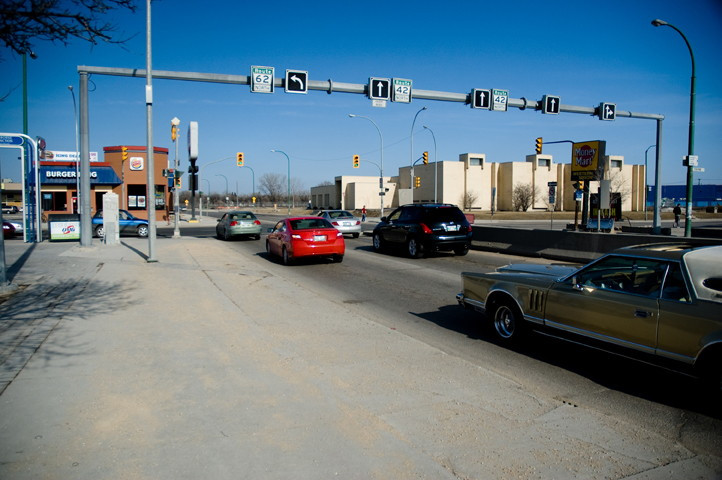How a freeway could help downtown
Integration, not segregation would return city streets to former glory
Winnipeg does not have any freeways. For many cities, this would be a legacy of planning that favoured residents and their uses over the schemes of traffic engineers. In Winnipeg’s case, it was simply a matter of money: the city has always been too poor to afford them.
Still, the shortage of funds did not stop traffic planners. In the absence of freeways, and with most of Winnipeg’s wide streets radiating from downtown, streets were sacrificed to the needs of crosstown and commuting traffic. Many downtown streets were widened and converted to one-way traffic. A turn-off lane was cut at the corner of River and Osborne, and Portage and Main was closed to pedestrians – the ultimate triumph of civic misanthropy.
The problem was not the presence of motor vehicles, but the overpowering accommodation of them.
Throughout history, cities were able to thrive with the same general principles through the advancement of different transportation technologies: the horsecart, the bicycle and the electric streetcar.
For their first few decades in the city, automobiles were able to conform to this pattern. A look at a photo of a Winnipeg street in 1946 – well into the age of the automobile – shows downtown roadways that were just as mixed in their uses as the buildings that lined them. The chief function of roads were the conveyance of vehicles, but they also served as routes for cyclists and horse-pulled delivery wagons, the locations of streetcar stops, parking spaces and loading zones. The mixed uses of the roadway slowed traffic enough that a pedestrian could feel comfortable standing in the middle of Portage and Main mere feet from an oncoming car.
Modern traffic planning arose as a way to eliminate this organized complexity on city streets, allowing their users behind the wheel to become unconscious. The only function of roadways became to move vehicles as quickly and simply as possible.
After more than half a century of this centralized micro-management, Winnipeg’s motorists, cyclists and pedestrians have all become quite bad at co-existing. Any affront to the natural order of the roadway erupts in irrational aggression. While closing streets for bikeways or pedestrian corridors might seem progressive and hip, they arise from this same philosophy of spatial separation.
“ Modern traffic planning arose as a way to eliminate this organized complexity on city streets, allowing their users behind the wheel to become unconscious.
Compared to the traditions of good urbanism which have survived for more than 2,400 years, the pseudo-science of traffic planning is a flash in the pan. Upholding it over traditional urbanism is like saying, “You listen to Mozart? You should listen to Lawrence Welk; his music is much more contemporary.”
Most of Europe recognizes this, and many North American cities are rediscovering it and learning from their mistakes. Winnipeg, not so much.
Recently, I was discussing with someone from Winnipeg’s planning department ways to encourage new housing downtown. I suggested that the easiest thing would be to end rush-hour parking restrictions, create more on-street parking spaces and convert some streets back to two-way traffic. That, the planner explained matter-of-factly, was an issue for the traffic department, and they are only interested in the movement of vehicles. Whatever else goes on the streets, he said, is not their concern.
Perhaps the best solution is to build a limited-access freeway that rings the city, with all the cloverleaf interchanges, off-ramps and on-ramps they can pay for. This would eliminate the need for cross-town car and truck traffic to have to use downtown streets. Let the traffic planners have new roadways to focus their phony principles on and let them abandon the campaign of destruction of city streets as urban space.
City streets can then be governed by the organic order of complexity and mixed uses that, while perhaps slowing commute times by a couple of minutes, make cities great.
Robert Galston is a University of Winnipeg student who writes about urban issues. Check out his blog at http://riseandsprawl.blogspot.com
Published in Volume 64, Number 25 of The Uniter (April 1, 2010)







